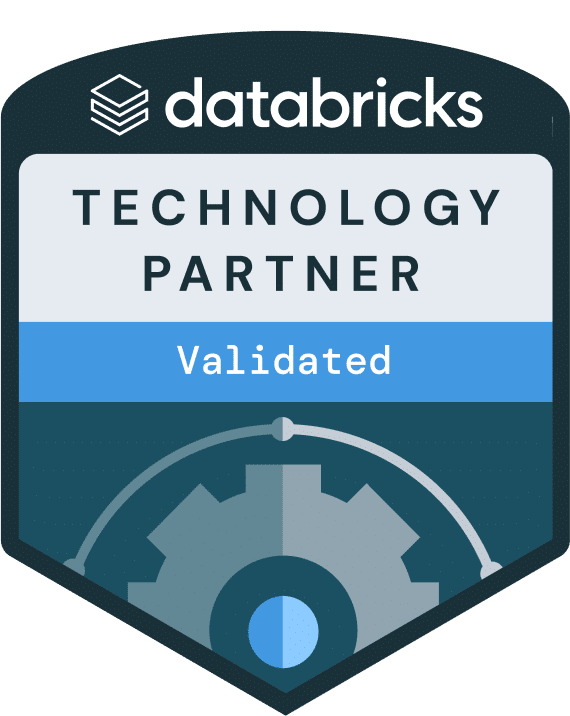DataGalaxy is a technology partner validated by Databricks

What the Databricks connector unlocks
Extended governance beyond Unity Catalog
Databricks ensures data security and access control; DataGalaxy extends that governance across the enterprise.
Gain full cross-platform lineage
DataGalaxy combines Databricks lineage with external sources, BI dashboards, and cloud data warehouses to provide a complete, end-to-end view of data movement and usage.
Build and govern business-ready data products
Databricks creates powerful data and AI products; DataGalaxy makes them trusted and reusable.
Simplify compliance and policy management
Easily connect Databricks assets to GDPR, NIS2, or internal governance frameworks.

Cross-platform lineage and visibility
DataGalaxy extends Unity Catalog lineage beyond Databricks to include ingestion pipelines, BI tools, and cloud data warehouses.
This unified view of data flows helps teams understand dependencies, assess impact, and ensure every dataset and model is used with confidence and control.
Add meaning to your notebooks, pipelines, and models
Databricks assets are fully contextualized in DataGalaxy. Tables, notebooks, and models are documented with metadata, business definitions, and governance rules, linking technical workflows to ownership, compliance, and operational visibility across the data ecosystem.
Define and apply rules and policies
Link Databricks datasets, notebooks, and models to governance rules and policies. Each asset follows clear standards for access, retention, and quality to ensure consistent compliance across your Lakehouse.
Smart suggestions for faster curation
Leverage AI-driven suggestions to automatically identify sensitive data, propose PII tags, and classify Databricks assets based on metadata and usage patterns.
Connect Databricks to your full data ecosystem.
See all your connectors
Expand data product visibility across the enterprise
Databricks makes it easy to build and share data products within the Lakehouse. DataGalaxy takes it further by centralizing every data product, whether it comes from Databricks, a BI tool, or another platform, into one governed platform.
Teams can define ownership, purpose, and lifecycle for each product, ensuring a consistent and trusted experience across the entire data landscape.
Business alignment and value tracking
DataGalaxy captures the “why” behind every project by linking Databricks pipelines and AI models to business objectives and measurable outcomes.
It helps organizations monitor adoption, track impact, and ensure that every Databricks initiative contributes directly to strategic value.
Why Databricks teams
choose DataGalaxy
- End-to-end visibility from ingestion to insight
- Cross-platform governance beyond the Databricks perimeter
- Accelerated adoption with self-service discovery
- Automated compliance and audit readiness
- Real-time ownership and accountability tracking
Databricks executes. DataGalaxy makes every execution meaningful.
Loved by our clients





FAQ
- What is Databricks?
-
Databricks is a cloud-native platform built for data engineering, machine learning, and analytics. It unifies data science and data engineering workflows on top of Apache Spark. Connecting Databricks to DataGalaxy brings governance, lineage, and semantic context to pipelines, notebooks, and AI models—all within a shared framework.
- What Databricks assets can be integrated with DataGalaxy?
-
DataGalaxy supports the integration of key Databricks assets including Delta tables, notebooks, and machine learning models. Each asset is enriched with full metadata context, making it easy to document, govern, and align your technical workflows with business objectives.
- Can I view governance and definitions directly in Databricks?
-
Yes. The integration allows you to embed governance elements like definitions, roles, and trust indicators directly into the Databricks interface. This ensures that data practitioners have access to critical context while working in notebooks, pipelines, or ML environments—without leaving their workspace.
- Does the connector support end-to-end data lineage?
-
Absolutely. DataGalaxy automatically maps and visualizes the flow of data across your Databricks pipelines, from raw ingestion to transformed datasets and downstream models or dashboards. This end-to-end lineage helps identify dependencies, track changes, and enhance accountability across your data lifecycle.
- How does DataGalaxy turn governance into an enabler in Databricks?
-
Instead of slowing down innovation, DataGalaxy embeds governance natively into Databricks workflows—ensuring transparency, lifecycle documentation, and cross-team collaboration. This transforms governance from a bottleneck into a catalyst for trusted, agile data and AI delivery.
- How does DataGalaxy integrate with Databricks?
-
With DataGalaxy, teams can catalog and govern assets from Databricks — including tables, notebooks, Delta Lake metadata, and more. This ensures data used for analytics or AI workloads is trusted, discoverable, and documented across your stack.
